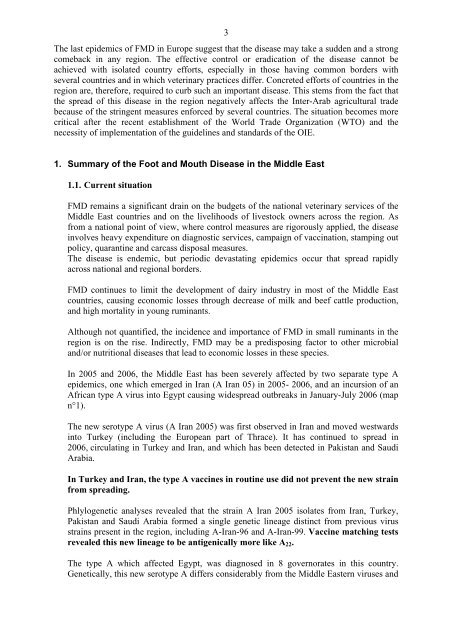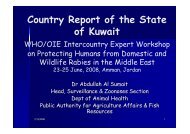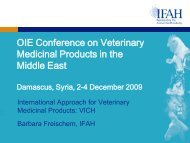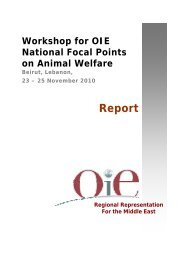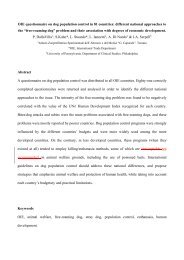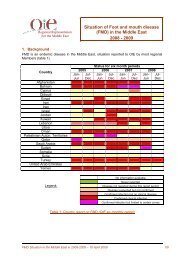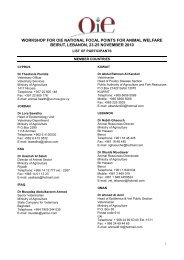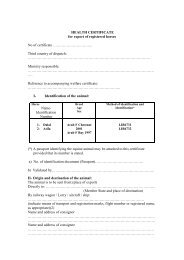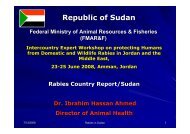2Indeed, regard<strong>in</strong>g absence <strong>in</strong> most countries of biosecurity measures, <strong>in</strong>volv<strong>in</strong>g strict bordercontrol, early detection program for new stra<strong>in</strong>s, confidence <strong>in</strong> analyses realised by <strong>the</strong>national labs, epidemiological survey, vacc<strong>in</strong>ation moni<strong>to</strong>r<strong>in</strong>g, cont<strong>in</strong>gency plans….are asmany fac<strong>to</strong>rs promot<strong>in</strong>g <strong>the</strong> spread of <strong>the</strong> disease, notably <strong>the</strong> epidemic form.Unfortunately, due <strong>to</strong> <strong>the</strong> import<strong>in</strong>g capacity of <strong>the</strong> <strong>Middle</strong> <strong>East</strong>, <strong>the</strong> region was left beh<strong>in</strong>d<strong>the</strong> major <strong>in</strong>ternational animal health programs that were elaborated for <strong>the</strong> control of majortransboundary animal diseases <strong>in</strong>clud<strong>in</strong>g <strong>FMD</strong>. Countries of <strong>the</strong> <strong>Middle</strong> <strong>East</strong> were<strong>in</strong>dividually <strong>in</strong>volved <strong>in</strong> different programs of o<strong>the</strong>r regions which led <strong>to</strong> more mistreatmen<strong>to</strong>f <strong>the</strong> region as a unique <strong>and</strong> <strong>in</strong>tegrated epidemiological block.Thus, <strong>to</strong> control <strong>FMD</strong> worldwide, <strong>the</strong> situation of this disease <strong>in</strong> <strong>Middle</strong> <strong>East</strong>ern countriesshould be treated as a priority.So, <strong>the</strong> implementation of a regional project <strong>to</strong> control <strong>FMD</strong> <strong>in</strong> <strong>the</strong> <strong>Middle</strong> <strong>East</strong> is essential.This was highlighted dur<strong>in</strong>g <strong>the</strong> 3 rd Roundtable Meet<strong>in</strong>g on <strong>FMD</strong> control <strong>in</strong> <strong>the</strong> <strong>Middle</strong> <strong>East</strong><strong>and</strong> North Africa, Damascus, Syria, November 6-7 th 2006, where one of <strong>the</strong> majorrecommendation made is <strong>to</strong> implement such project with<strong>in</strong> <strong>the</strong> <strong>OIE</strong>/FAO global framework of<strong>the</strong> progressive control of transboundary animal disease program (GF-TADs) <strong>and</strong> cocoord<strong>in</strong>atedby <strong>the</strong> Regional Animal Health Centre (RAHC) established <strong>to</strong> provide expertise<strong>and</strong> assistance especially <strong>in</strong> major emergency cases <strong>in</strong> <strong>the</strong> region.______________________________________The <strong>Middle</strong> <strong>East</strong> region is act<strong>in</strong>g as a mix<strong>in</strong>g vessel <strong>to</strong> animals from different sources <strong>in</strong><strong>the</strong> world. As an important import<strong>in</strong>g region, <strong>the</strong> <strong>Middle</strong> <strong>East</strong> receives animals <strong>and</strong> animalproducts from different parts of <strong>the</strong> world <strong>and</strong> mostly from regions where <strong>FMD</strong> is endemic.The <strong>in</strong>effective <strong>in</strong>frastructure of <strong>the</strong> veter<strong>in</strong>ary quarant<strong>in</strong>e bodies <strong>and</strong> <strong>the</strong> lack of appropriatediagnostic capabilities always lead <strong>to</strong> <strong>the</strong> absence of any early warn<strong>in</strong>g system. The numberof under-tra<strong>in</strong>ed veter<strong>in</strong>ary personnel compared with <strong>the</strong> professional veter<strong>in</strong>arians <strong>in</strong>-chargeof disease surveillance <strong>and</strong> moni<strong>to</strong>r<strong>in</strong>g of animal diseases especially <strong>FMD</strong> makes it difficult<strong>to</strong> achieve proper control of <strong>the</strong> disease.The lack of <strong>in</strong>formation exchange among countries of <strong>the</strong> regions <strong>and</strong> <strong>the</strong> uncontrolledimportation of veter<strong>in</strong>ary biologicals <strong>and</strong> vacc<strong>in</strong>es as well as <strong>the</strong> absence of proper qualitycontrol add <strong>to</strong> <strong>the</strong> risk fac<strong>to</strong>rs of more <strong>in</strong>troduction of <strong>the</strong> disease <strong>to</strong> <strong>the</strong> region <strong>and</strong> morethreat <strong>to</strong> <strong>the</strong> neighbor<strong>in</strong>g ones.As an air-borne disease, <strong>the</strong> potential of <strong>the</strong> spread of <strong>the</strong> disease <strong>to</strong> adjacent regions is<strong>in</strong>creas<strong>in</strong>gly considered consider<strong>in</strong>g <strong>the</strong> geographical location of <strong>the</strong> <strong>Middle</strong> <strong>East</strong> <strong>and</strong> <strong>the</strong><strong>in</strong>creas<strong>in</strong>g traffic <strong>and</strong> transportation of people <strong>and</strong> goods <strong>to</strong> <strong>and</strong> from <strong>the</strong> region. The ports of<strong>the</strong> <strong>Middle</strong> <strong>East</strong> <strong>and</strong> escalat<strong>in</strong>g volume of shipments <strong>and</strong> transit sec<strong>to</strong>r are o<strong>the</strong>r <strong>in</strong>direct <strong>and</strong>unforeseen threats.Unfortunately, due <strong>to</strong> <strong>the</strong> import<strong>in</strong>g capacity of <strong>the</strong> <strong>Middle</strong> <strong>East</strong>, <strong>the</strong> region was left beh<strong>in</strong>d<strong>the</strong> major <strong>in</strong>ternational animal health programs that were elaborated for <strong>the</strong> control ofmajor transboundary animal diseases <strong>in</strong>clud<strong>in</strong>g <strong>FMD</strong>. Countries of <strong>the</strong> <strong>Middle</strong> <strong>East</strong> were<strong>in</strong>dividually <strong>in</strong>volved <strong>in</strong> different programs of o<strong>the</strong>r regions which led <strong>to</strong> more mistreatmen<strong>to</strong>f <strong>the</strong> region as a unique <strong>and</strong> <strong>in</strong>tegrated epidemiological block.
3The last epidemics of <strong>FMD</strong> <strong>in</strong> Europe suggest that <strong>the</strong> disease may take a sudden <strong>and</strong> a strongcomeback <strong>in</strong> any region. The effective control or eradication of <strong>the</strong> disease cannot beachieved with isolated country efforts, especially <strong>in</strong> those hav<strong>in</strong>g common borders withseveral countries <strong>and</strong> <strong>in</strong> which veter<strong>in</strong>ary practices differ. Concreted efforts of countries <strong>in</strong> <strong>the</strong>region are, <strong>the</strong>refore, required <strong>to</strong> curb such an important disease. This stems from <strong>the</strong> fact that<strong>the</strong> spread of this disease <strong>in</strong> <strong>the</strong> region negatively affects <strong>the</strong> Inter-Arab agricultural tradebecause of <strong>the</strong> str<strong>in</strong>gent measures enforced by several countries. The situation becomes morecritical after <strong>the</strong> recent establishment of <strong>the</strong> World Trade Organization (WTO) <strong>and</strong> <strong>the</strong>necessity of implementation of <strong>the</strong> guidel<strong>in</strong>es <strong>and</strong> st<strong>and</strong>ards of <strong>the</strong> <strong>OIE</strong>.1. Summary of <strong>the</strong> Foot <strong>and</strong> Mouth Disease <strong>in</strong> <strong>the</strong> <strong>Middle</strong> <strong>East</strong>1.1. Current situation<strong>FMD</strong> rema<strong>in</strong>s a significant dra<strong>in</strong> on <strong>the</strong> budgets of <strong>the</strong> national veter<strong>in</strong>ary services of <strong>the</strong><strong>Middle</strong> <strong>East</strong> countries <strong>and</strong> on <strong>the</strong> livelihoods of lives<strong>to</strong>ck owners across <strong>the</strong> region. Asfrom a national po<strong>in</strong>t of view, where control measures are rigorously applied, <strong>the</strong> disease<strong>in</strong>volves heavy expenditure on diagnostic services, campaign of vacc<strong>in</strong>ation, stamp<strong>in</strong>g outpolicy, quarant<strong>in</strong>e <strong>and</strong> carcass disposal measures.The disease is endemic, but periodic devastat<strong>in</strong>g epidemics occur that spread rapidlyacross national <strong>and</strong> regional borders.<strong>FMD</strong> cont<strong>in</strong>ues <strong>to</strong> limit <strong>the</strong> development of dairy <strong>in</strong>dustry <strong>in</strong> most of <strong>the</strong> <strong>Middle</strong> <strong>East</strong>countries, caus<strong>in</strong>g economic losses through decrease of milk <strong>and</strong> beef cattle production,<strong>and</strong> high mortality <strong>in</strong> young rum<strong>in</strong>ants.Although not quantified, <strong>the</strong> <strong>in</strong>cidence <strong>and</strong> importance of <strong>FMD</strong> <strong>in</strong> small rum<strong>in</strong>ants <strong>in</strong> <strong>the</strong>region is on <strong>the</strong> rise. Indirectly, <strong>FMD</strong> may be a predispos<strong>in</strong>g fac<strong>to</strong>r <strong>to</strong> o<strong>the</strong>r microbial<strong>and</strong>/or nutritional diseases that lead <strong>to</strong> economic losses <strong>in</strong> <strong>the</strong>se species.In 2005 <strong>and</strong> 2006, <strong>the</strong> <strong>Middle</strong> <strong>East</strong> has been severely affected by two separate type Aepidemics, one which emerged <strong>in</strong> Iran (A Iran 05) <strong>in</strong> 2005- 2006, <strong>and</strong> an <strong>in</strong>cursion of anAfrican type A virus <strong>in</strong><strong>to</strong> Egypt caus<strong>in</strong>g widespread outbreaks <strong>in</strong> January-July 2006 (mapn°1).The new serotype A virus (A Iran 2005) was first observed <strong>in</strong> Iran <strong>and</strong> moved westwards<strong>in</strong><strong>to</strong> Turkey (<strong>in</strong>clud<strong>in</strong>g <strong>the</strong> European part of Thrace). It has cont<strong>in</strong>ued <strong>to</strong> spread <strong>in</strong>2006, circulat<strong>in</strong>g <strong>in</strong> Turkey <strong>and</strong> Iran, <strong>and</strong> which has been detected <strong>in</strong> Pakistan <strong>and</strong> SaudiArabia.In Turkey <strong>and</strong> Iran, <strong>the</strong> type A vacc<strong>in</strong>es <strong>in</strong> rout<strong>in</strong>e use did not prevent <strong>the</strong> new stra<strong>in</strong>from spread<strong>in</strong>g.Phlylogenetic analyses revealed that <strong>the</strong> stra<strong>in</strong> A Iran 2005 isolates from Iran, Turkey,Pakistan <strong>and</strong> Saudi Arabia formed a s<strong>in</strong>gle genetic l<strong>in</strong>eage dist<strong>in</strong>ct from previous virusstra<strong>in</strong>s present <strong>in</strong> <strong>the</strong> region, <strong>in</strong>clud<strong>in</strong>g A-Iran-96 <strong>and</strong> A-Iran-99. Vacc<strong>in</strong>e match<strong>in</strong>g testsrevealed this new l<strong>in</strong>eage <strong>to</strong> be antigenically more like A 22 .The type A which affected Egypt, was diagnosed <strong>in</strong> 8 governorates <strong>in</strong> this country.Genetically, this new serotype A differs considerably from <strong>the</strong> <strong>Middle</strong> <strong>East</strong>ern viruses <strong>and</strong>


